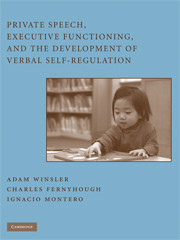Book contents
- Frontmatter
- Contents
- List of Contributors
- Foreword
- Introduction
- Part I Theoretical and Biological Foundations
- Part II Language, Communication, Social Cognition, and Awareness
- Part III Symbols and Tools throughout the Life Span
- Part IV Motivational and Educational Applications
- 15 Private Speech and Motivation: The Role of Language in a Sociocultural Account of Motivational Processes
- 16 Creativity and Private Speech in Young Children
- 17 Early Childhood Teachers' Awareness, Beliefs, and Practices toward Children's Private Speech
- Afterword
- Index
- References
15 - Private Speech and Motivation: The Role of Language in a Sociocultural Account of Motivational Processes
from Part IV - Motivational and Educational Applications
Published online by Cambridge University Press: 29 July 2009
- Frontmatter
- Contents
- List of Contributors
- Foreword
- Introduction
- Part I Theoretical and Biological Foundations
- Part II Language, Communication, Social Cognition, and Awareness
- Part III Symbols and Tools throughout the Life Span
- Part IV Motivational and Educational Applications
- 15 Private Speech and Motivation: The Role of Language in a Sociocultural Account of Motivational Processes
- 16 Creativity and Private Speech in Young Children
- 17 Early Childhood Teachers' Awareness, Beliefs, and Practices toward Children's Private Speech
- Afterword
- Index
- References
Summary
Inspired by Vygotskian theory, a large number of studies have emerged in the past 4 decades investigating the mediation of self-regulation through children's use of private speech (Berk, 1992; Winsler, Chapter 1 of this volume; Zivin, 1979). It is now widely accepted that children use private speech as a tool for thinking and as a metacognitive mediator of self-regulatory function (Winsler, Díaz, & Montero, 1997; Winsler & Naglieri, 2003). Within the Vygotskian tradition, it is assumed that private speech represents children's capacity to verbally mediate their own thoughts and actions and that this capacity is social in origin (Berk & Spuhl, 1995; Berk & Winsler, 1995). Children essentially appropriate the capacity to collaborate with themselves from the collaborations they have had with others. Therefore, we now understand that private speech is speech for self that mediates the development of higher psychological processes (Wertsch & Stone, 1985).
The focus of this chapter is to build on this consensus in the field and extend the discussion regarding private speech mediation into the more conative and motivational aspects of self-regulation. This discussion is based on two subtle, yet important, ideas found within Vygotsky's theory. The first notion embedded in his writings warns us that in order to truly understand the manner in which private speech mediates self-regulatory development, we must understand self-regulation as a union of intellectual and affective development. In his words:
Among the most basic defects of traditional approaches to the study of psychology has been the isolation of the intellectual from the volitional and affective aspects of consciousness … thinking was divorced from the full vitality of life, from the motives, interests, and inclinations of the thinking individual
(Vygotsky, 1934/1987, p. 50).Information
- Type
- Chapter
- Information
- Private Speech, Executive Functioning, and the Development of Verbal Self-Regulation , pp. 201 - 223Publisher: Cambridge University PressPrint publication year: 2009
References
Accessibility standard: Unknown
Why this information is here
This section outlines the accessibility features of this content - including support for screen readers, full keyboard navigation and high-contrast display options. This may not be relevant for you.Accessibility Information
- 8
- Cited by
